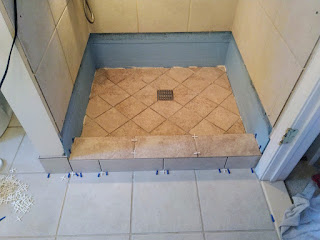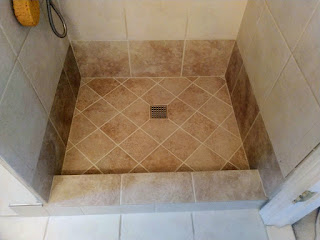Shower Repair Blog
Is your shower leaking downstairs, causing damage to your main floor or basement? Discover the reasons why worn-out showers leak downstairs in this blog. You're not alone - water-damaged shower repairs constitute a billion-dollar industry.
Modern era waterproofing technology has revolutionized water damaged shower repair jobs, especially with the advent of 100% waterproof wet rooms. In the past, showers often suffered from a multitude of issues, including water leakage, persistent black mold, musty odors, cracks in grout joints, missing grout, loose tiles, and even insect infestations. These problems were largely attributed to the absence of adequate waterproofing in older shower designs. Traditional showers, despite being the top sellers in North America, were lacking the advanced waterproofing features that are now found in contemporary options like Schluter wet rooms.
The prevalence and popularity of these outdated showers can be attributed to their affordability and widespread availability. However, their long-term performance falls short due to their outdated design and lack of waterproofing measures. Older showers typically employ a basic setup with a shower pan liner and a small flange drainage system. While the liner may initially convey a sense of effectiveness in containing water, it ultimately proves to be less waterproof than expected. This flaw becomes evident as the liner is connected to the drain through bolts and a collar, compromising its waterproofing integrity. Moreover, the layer of dry pack mud placed atop the pan liner becomes saturated with water during use, leading to moisture infiltration behind the shower walls, resulting in the growth of black mold and water damage. Over time, accumulation of rust and general deterioration further contribute to water leakage and structural damage, rendering the showers irreparable.
The introduction of modern waterproofing technology, exemplified by 100% waterproof wet rooms, has addressed these enduring issues by providing comprehensive and highly effective waterproofing solutions. With these innovative wet rooms, complete waterproofing is guaranteed, effectively preventing water damage, mold growth, and structural deterioration. By adopting modern waterproofing technology, water damaged shower repair jobs can now be undertaken with confidence, offering homeowners and builders durable and reliable solutions.
The occurrence of water damage can be attributed in part to substandard craftsmanship, often observed in the construction of residential properties. It is a prevalent issue within the construction industry, characterized by various deviations from best practices. Instances include the deliberate or inadvertent application of inappropriate construction materials and the engagement of unskilled labor. Such oversights often result in the improper installation of crucial structural components, exemplified by the penetration of the shower pan liner with fasteners or the failure to meet the requisite 24-hour flood test, as stipulated by building codes. These shortcomings collectively contribute to the vulnerability of structures to water damage.
The historical origins of waterproofing technology can be traced back to ancient civilizations, notably the Romans, who demonstrated advanced proficiency in the application of waterproofing methodologies to structures such as saunas, baths, and swimming pools. Particularly noteworthy is the enduring testament of their expertise found in numerous extant Roman baths across Europe, which continue to adeptly contain water, showcasing the efficacy and longevity of their waterproofing practices. Ancient Rome boasted advanced waterproofing techniques, employing the Opus Signinum method, which consisted of a mixture of lime, sand, and crushed pottery to waterproof their aqueducts, cisterns, and thermal baths. This technique, also known as Coccio Pesto, served as a widely utilized form of concrete throughout the Roman Empire. In addition, historical waterproofing methods included various compositions, such as clay, natural resin, and fats, a combination of soap-oil and volcano ash, seawater and lime, and lime, sand, black soap, and beeswax. Furthermore, bitumen has served as a prevalent waterproofing solution for vessels, buildings, and showers throughout history, with contemporary usage in California and other southern states in the US for "Hot Mop Shower Pans". These historical methodologies offer compelling avenues for further scholarly exploration and research. Opus signinum, a mortar technique that often incorporates very small pieces of broken pottery, was commonly employed in applications involving water or damp conditions, such as flooring, lining baths, aqueducts, and cisterns.
Inquiries from clients often revolve around differentiating traditional showers from wet rooms. It is commonplace for both builders and clientele to demonstrate limited awareness of the concept of wet rooms. An orthodox shower lacks sophisticated waterproofing infrastructure; specifically, the absence of a polyethylene membrane atop the shower pan and a substantial flange drain to establish a waterproof seal. Consequently, the perpetually wet shower pan mortar bed leads to long-term challenges such as moisture, mold, and rust.
When considering wet rooms, the name Schluter, originating from Germany in the 1960s, is often the first to come to mind. A multitude of shower and wet room brand names are available in the market.
The traditional version comprises a slurry kit, applied using a brush or roller and corner tape. In contrast, the new kit incorporates a large flange drainage, polyethylene membrane sheet, prefabricated corner seals, and, crucially, a sealant to adhere the membrane to the flange and surrounding areas, such as Schluter Kerdi Coll-L. The waterproofing seal is applied on top of the large flange and corner seals, effectively preventing water from permeating the mud bed and maintaining the shower's dryness and mold-free environment. The disparity between the conventional shower and the wet room is significant. Visual comparison is available below.
As a professional in the wet room industry, it is imperative to remain consistently updated on advancements in materials and technology. The rapid progression of the wet room sector necessitates a proactive approach to staying informed and integrating new technologies into our practices, ensuring that our services uphold the highest standards of quality and innovation.
Recently, I have been utilizing the traditional bond flange drain kit from FloFX, which has received positive feedback from our clientele. These drainage systems are lauded for their durability and ease of installation, and their domestic manufacturing further enhances their appeal. In my professional experience, these drains are among the most superior options available for wet room installations. Their exceptional quality prompted my anticipation to acquire them upon my return to the United States. I highly recommend considering them for your projects.
When contemplating your next shower purchase, it is imperative to conduct a comprehensive assessment of available options, whether they are from Old School Shower, Schluter, FloFX, or other providers. Each brand presents unique features, and the selection should be based on the specific requirements of the project.
Should you wish to share images from your recent shower repair project or seek further advice, please feel free to do so.
.jpg)


Comments
Post a Comment